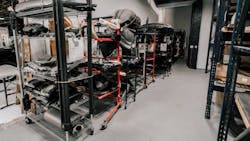Last month, we discussed the origin — then the definition — of blueprinting, what a bad blueprint looks like, and finally, what ‘"hands on the car" means. Now, let’s dive in.
Before a vehicle is brought into the Blueprint department, does it need a pre-wash? If so, do it. Owners/managers who tolerate techs working on dirty cars need to fire themselves, and besides that, it allows our people to document all the unrelated prior damage (UPD) & damage. The pre-wash needs to be done at drop-off ASAP rather than prior to pulling the vehicle into the Blueprint bay, as the tech will be removing liners/valances while water continues to drip on them. For years, we would just bring the car in and dive in with tools. That, my friends, was a recipe for disaster.
Any shop operator who says he or she has a process for this or that, but it’s not written down, is really lying to themselves. As I was taught, "If it’s not in writing, it’s NOT true." We run blueprint teams with one tech and one writer. They have a step-by-step written process on laminated sheets. One side has the steps for the tech and the other side has the steps for the writer, and one cannot get ahead of the other. Again, this is a team and even the way the vehicle is parked in the bay is crucial. Let’s say the car is hit in the right front; then the car is parked with the right front closest to the workstation and table. Remember, we cannot add a line on the estimate to charge for "excessive walking"! Sidenote: Two-person seasoned teams can blueprint around 80-90 estimate hours per day.
Here is the first step in our blueprint process: "B.P. tech 1.1: Get next car. Determine if pre-repair test drive is required. If post is required, write on windshield. Pull into B.P. bay, complete check-in and pre-scan. B.P. writer 1.1: Fill out/complete information in CCC work file tabs. Inspection, vehicle tab, exterior/VIN/ODO photos, rates, repair plan, drop off date and repair start on every job."
I know some may be saying to themselves, “There is no way we could run a one-for-one team like this, as I have one writer for 3-4 techs.” I get it, trust me. But to eliminate "firefighting" downstream for additional supplements/parts orders etc. and missed delivery dates, this is what it takes. Here is a quote from one of my great mentors: “You know why most shops have those fancy mobile estimating carts, don’t you? They just roll them all over the place doing supplements all day!” Hmm...
One thing we don’t want to skip over is, "Vehicle check-in." If this is not done correctly or at all, regrets and firefighting will follow. Every vehicle we work on in our shop has a thorough check-in. Here is a short list of function tests: Turn lamps, headlamps, taillamps, license lamps, fog lamps, radio, horn, front and rear wipers/washers, power windows/locks, mirrors/folding, seats, sunroofs, keyfob, etc. A couple more crucial items from our experience: Test the battery, and if bad, notify the owner ASAP they have an issue at the beginning. I have bought many batteries over the decades, and this is 100% preventable! When it comes to UPD, the car needs to be walked with the customer at drop off and upsells discussed then. We still photograph all UPD at check-in just for insurance. Lastly, please note any preexisting dash lights at check-in!
One of the next steps is how we handle parts carts, and they’re obviously handled differently in every shop. For my shop, we have an "R&I cart" and a "red-cart" for each R.O. We just label the R&I cart with the windshield tag from CCC. Our red-cart is smaller, and the only parts that can be placed on this cart are ones needing replaced. We do have ringed laminated cards that can be attached to the Red-Cart and labeled with parts that were missing on arrival, example: Grille emblem, LH foglamp, etc. Side note: Parts removed that need repaired get a yellow tag and are placed visibly on the R&I-Cart.
As far as having a visual system, here is another example: When parts mirror-matching takes place, all the bad parts from the Red-Cart are matched to the new ones and then thrown away. If this cart is empty when done, we have just confirmed all the parts are here. No guessing, no finger-pointing, no whatever, as to whether we have all the parts or not.
Next month we will jump right back into where we left off this month with what constitutes a proper dismantle, OEM procedures, displaying and photographing parts, etc. Here’s a quote from one of my great mentors: “When we focus on quality in everything we do, that outcome will be speed.” Otherwise, slow down to speed up!
